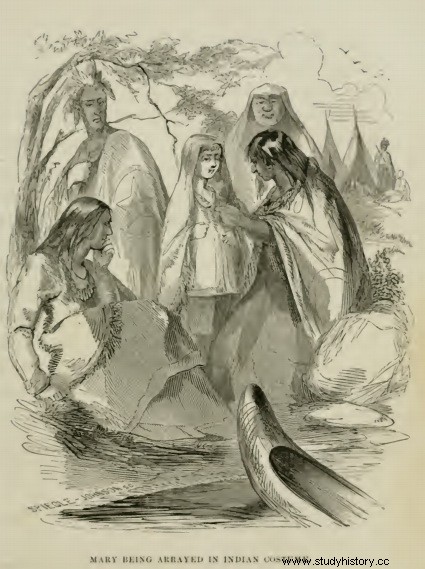Mary Jemison (Deh-he-wä-mis) (1743 – 1833) was an American woman, abducted as a child by Native Americans and later assimilated into Native American culture. She is best known for negotiating a treaty for her tribe.
The Kidnapping of Mary
 Daughter of Jane and Thomas Jemison, Mary was born in the fall of 1743, on the ship that took her , with his Irish parents and their other children, in America. Upon arriving in Philadelphia, they joined other Scottish and Irish immigrants and headed west to Pennsylvania to find cheap land. Arrived at the limit zone of the establishment of European populations (the Frontier), the Jemisons settled in Iroquois territory.
Daughter of Jane and Thomas Jemison, Mary was born in the fall of 1743, on the ship that took her , with his Irish parents and their other children, in America. Upon arriving in Philadelphia, they joined other Scottish and Irish immigrants and headed west to Pennsylvania to find cheap land. Arrived at the limit zone of the establishment of European populations (the Frontier), the Jemisons settled in Iroquois territory.
From 1754, the rivalries between France and England burst into open conflict in America, during the War of the Conquest. Both nations have Native American allies, which they particularly use in border areas. One morning in 1755, a raid by four Frenchmen and six Shawnees (or Shawnees) captured Mary, her parents, her siblings (except her two older brothers), and a young boy from another family. On their way to Fort Duquesne (now Pittsburgh), the Shawnees kill the prisoners except Mary and the young boy who are spared, considered young enough for adoption.
Among the Senecas
Arrived at the fort, Mary Jemison is kidnapped by, or given to, Senecas who take her to their camp. There, she was adopted by a family who renamed her Deh-he-wä-mis (or Dehgewanus, Dehgewanus and Degiwanus, Dickewamis), meaning "pretty girl" or "nice thing". She grew up with the Senecas and eventually married a Delaware Indian, Sheninjee, with whom she had a son whom she named Thomas, after her father. Together, they embark on a long journey of 1,100 kilometers, along the Genesee River, towards the Sehgahunda Valley (in present-day New York State). Falling ill on the way, Sheninjee will not reach his destination, unlike his wife and son.
The Treaty of the Big Tree
A widow, Deh-he-wä-mis and her son are welcomed by relatives of her husband. Later, she remarried a Seneca named Hiakatoo, with whom she had six children. During the American War of Independence, the Seneca allied with the English, hoping to repel the colonizers. At the end of the war, as allies of England, the Senecas must abandon their lands for the benefit of the United States. Deh-he-wä-mis volunteers for negotiations and land sales. A skilful negotiator, she helped to obtain more favorable terms in the cession of lands, through the "Treaty of the Big Tree", signed in September 1797.
Deh-he-wä-mis spends the rest of her life with the Senecas, known as "the white woman of Genesee". Towards the end of her life, she related her life to James E. Seaver, who published it in 1824 as Narrative of the Life of Mrs. Mary Jemison.
Deh-he-wä-mis / Mary Jemison died on September 19, 1833.
